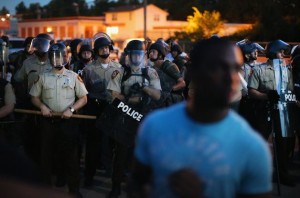Against Prediction: #Ferguson

From Bernard E. Harcourt’s Against Prediction: Profiling, Policing, and Punishing in an Actuarial Age
***
The ratchet [also] contributes to an exaggerated general perception in the public imagination and among police officers of an association between being African American and being a criminal—between, in Dorothy Roberts’s words, “blackness and criminality.” As she explains,
One of the main tests in American culture for distinguishing law-abiding from lawless people is their race. Many, if not most, Americans believe that Black people are “prone to violence” and make race-based assessments of the danger posed by strangers they encounter. The myth of Black criminality is part of a belief system deeply embedded in American culture that is premised on the superiority of whites and inferiority of Blacks. Stereotypes that originated in slavery are perpetuated today by the media and reinforced by the huge numbers of Blacks under criminal justice supervision. As Jody Armour puts it, “it is unrealistic to dispute the depressing conclusion that, for many Americans, crime has a black face.”
Roberts discusses one extremely revealing symptom of the “black face” of crime, namely, the strong tendency of white victims and eyewitnesses to misidentify suspects in cross-racial situations. Studies show a disproportionate rate of false identifications when the person identifying is white and the person identified is black. In face, according to Sheri Lynn Johnson, “this expectation is so strong that whites may observe an interracial scene in which a white person is the aggressor, yet remember the black person as the aggressor.” The black face has become the criminal in our collective subconscious. “The unconscious association between Blacks and crime is so powerful that it supersedes reality.” Roberts observes: ”it predisposes whites to literally see Black people as criminals. Their skin color marks Blacks as visibly lawless.”
This, in turn, further undermines the ability of African Americans to obtain employment or pursue educational opportunities. It has a delegitimizing effect on the criminal justice system that may encourage disaffected youths to commit crime. It may also erode community-police relations, hampering law enforcement efforts as minority community members become less willing to report crime, to testify, and to convict. The feedback mechanisms, in turn, accelerate the imbalance in the prison population and the growing correlation between race and criminality.
And the costs are deeply personal as well. Dorothy Roberts discusses the personal harm poignantly in a more private voice in her brilliant essay, Race, Vagueness, and the Social Meaning of Order-Maintenance Policing, sharing with the reader a conversation that she had with her sixteen-year-old son, who is African American:
In the middle of writing this Foreword, I had a revealing conversation with my sixteen-year-old son about police and loitering. I told my son that I was discussing the constitutionality of a city ordinance that allowed the police to disperse people talking on the sidewalk if any one of them looked as if he belonged in a gang. My son responded apathetically, “What’s new about that? The police do it all the time, anyway. They don’t like Black kids standing around stores where white people shop, so they tell us to move.” He then casually recounted a couple of instances when he and his friends were ordered by officers to move along when they gathered after school to shoot the breeze on the streets of our integrated community in New Jersey. He seemed resigned to this treatment as a fact of life, just another indignity of growing up Black in America. He was used to being viewed with suspicion: being hassled by police was similar to the way store owners followed him with hawk eyes as he walked through the aisles of neighborhood stores or women clutched their purses as he approached them on the street.
Even my relatively privileged son had become acculturated to one of the salient social norms of contemporary America: Black children, as well as adults, are presumed to be lawless, and that status is enforced by the police. He has learned that as a Black person he cannot expect to be treated with the same dignity and respect accorded his white classmates. Of course, Black teens in inner-city communities are subjected to more routine and brutal forms of police harassment.
To read more about Against Prediction, click here.